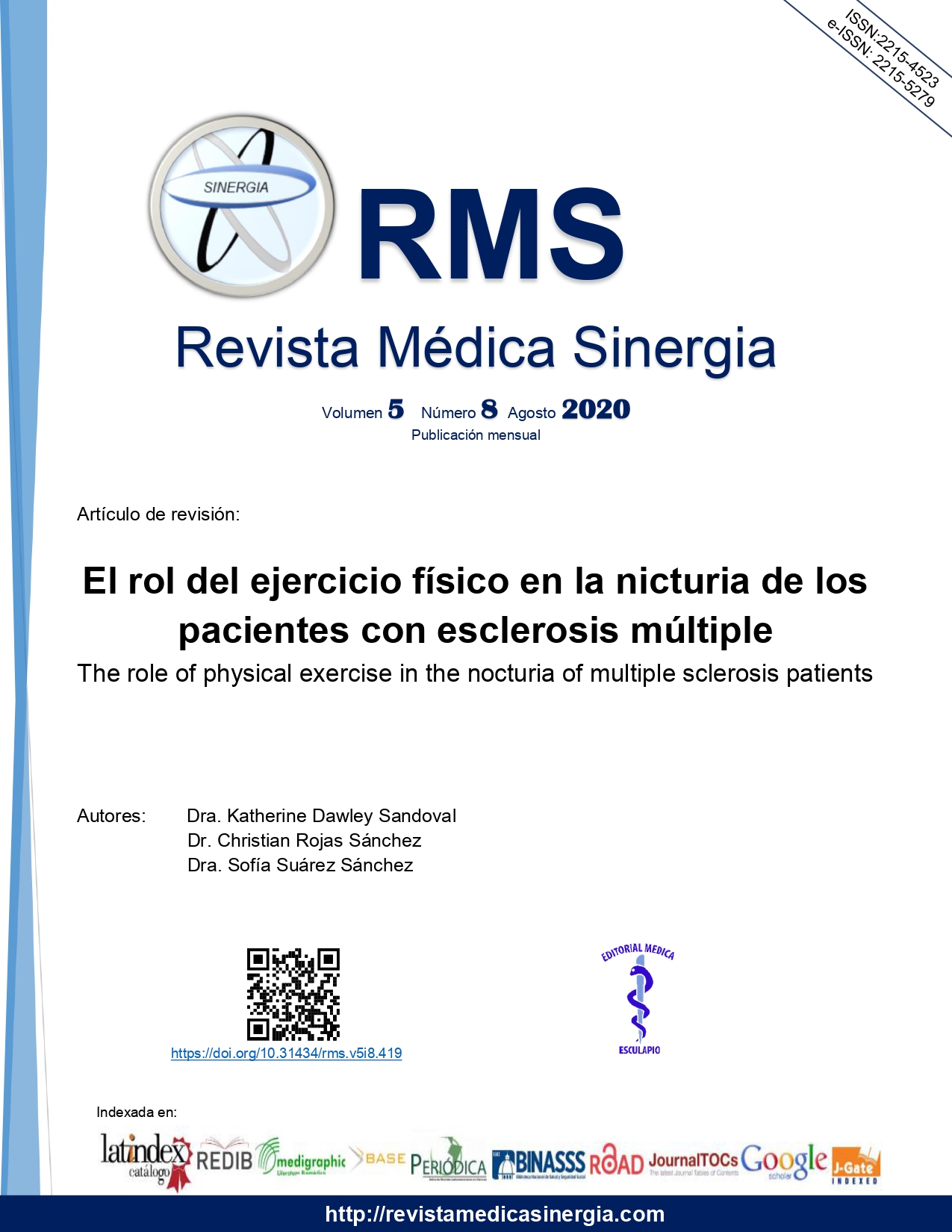Resumen
La esclerosis múltiple es la enfermedad crónica, inflamatoria y neurodegenerativa más prevalente del sistema nervioso central; la cual desarrolla lesiones desmielinizantes. El déficit a nivel de tracto urinario bajo en los pacientes con esclerosis múltiple, ocurre cuando la médula espinal se encuentra involucrada en la patología; y la nicturia, es uno de los principales síntomas urinarios que poseen estos pacientes. La actividad física y el ejercicio son potenciales terapias no farmacológicas que modulan el desarrollo de los síntomas y la progresión de la patología. El ejercicio físico regular corresponde a un elemento fundamental de la estrategia terapéutica de los pacientes con Esclerosis múltiple y nicturia. Se ha reportado una disminución de los episodios miccionales nocturnos en los pacientes que implementan un régimen de ejercicio físico.
Palabras clave
Citas
Reich DS, Lucchinetti CF, Calabresi PA. Multiple sclerosis. N Engl J Med. 2018;378(2):169-80. https://doi.org/10.1056/NEJMra1401483
Wallin MT, Culpepper WJ, Nichols E, Bhutta ZA, Gebrehiwot TT, Hay SI, et al. Global, regional, and national burden of multiple sclerosis 1990-2016: a systematic analysis for the Global Burden of Disease Study 2016. Lancet Neurol. 2019;18(3):269-85.mhttps://doi.org/10.1016/S1474-4422(18)30443-5
Breton L, Hentzen C, Turmel N, Chesnel C, Charlanes A. ScienceDirect Effect of a strong desire to void on walking speed in individuals with multiple sclerosis and urinary disorders. 2020;8-12.https://doi.org/10.1016/j.rehab.2019.11.007
Sand IK. Classification, diagnosis, and differential diagnosis of multiple sclerosis. Curr Opin Neurol. 2015;28(3):193-205. https://doi.org/10.1097/WCO.0000000000000206
Feys P, Moumdjian L, Van Halewyck F. Effects of an individual 12-week community- located "start-to-run" program on physical capacity, walking, fatigue, cognitive function, brain volumes, and structures in persons with multiple sclerosis. Mult Scler J. 2017;9(6):1-12. https://doi.org/10.1177/1352458517740211
Kalron A, Frid L, Aloni R, Menascu S, Givon U. Physical activity participation according to the pyramidal, sensory, and cerebellar functional systems in multiple sclerosis. J Neural Transm [Internet]. 2019;(0123456789). Disponible en: https://doi.org/10.1007/s00702-019-02099-5.
Wesnes K, Myhr K, Riise T, Cortese M, Pugliatti M, Boström I, et al. Physical activity is associated with a decreased multiple sclerosis risk: The EnvIMS study. 2017;1-8. https://doi.org/10.1177/1352458517694088
Richardson E V., Fifolt M, Barstow EA, Silveira SL, Sikes EM, Motl RW. The priorities of neurologists for exercise promotion in comprehensive multiple sclerosis care. Mult Scler Relat Disord [Internet]. 2020;38 (October 2019):101482.https://doi.org/10.1016/j.msard.2019.101482
Repovic P. Management of multiple sclerosis relapses. Contin Lifelong Learn Neurol. 2019;25(3):655-69. https://doi.org/10.1212/CON.0000000000000739
Panicker JN, Fowler CJ. Lower urinary tract dysfunction in patients with multiple sclerosis [Internet]. 1st ed. Vol. 130, Handbook of Clinical Neurology. Elsevier B.V.; 2015. 371-381 p.
https://doi.org/10.1016/B978-0-444-63247-0.00021-3
Akkoç Y, Ersöz M, Yüceyar N, Tunç H, Köklü K, Yoldaş TK, et al. Overactive bladder symptoms in patients with multiple sclerosis: Frequency, severity, diagnosis and treatment. J Spinal Cord Med. 2016;39(2):229-33.https://doi.org/10.1179/2045772315Y.0000000021
Rahnama’i MS. Neuromodulation for functional bladder disorders in patients with multiple sclerosis. Multiple Sclerosis Journal. 2019 Dec 09;:135245851989471. https://doi.org/10.1177/1352458519894714
Drake MJ, Canham L, Cotterill N, Delgado D, Homewood J, Inglis K, et al. Results of a randomized, double blind, placebo controlled, crossover trial of melatonin for treatment of Nocturia in adults with multiple sclerosis (MeNiMS). BMC Neurol. 2018;18(1):1-8. https://doi.org/10.1186/s12883-018-1114-4
Phé V, Chartier-Kastler E, Panicker JN. Management of neurogenic bladder in patients with multiple sclerosis. Nat Rev Urol [Internet]. 2016;13(5):275-88. https://doi.org/10.1038/nrurol.2016.53
Mauruc E, Guinet-Lacoste A, Falcou L, Manceau P, Verollet D, Le Breton F, et al. Nocturnal Urinary Disorders and Multiple Sclerosis: Clinical and Urodynamic Study of 309 Patients. J Urol. 2017;197(2):432-7.https://doi.org/10.1016/j.juro.2016.10.112
Maitin IB, Cruz E. Special Considerations and Assessment in Patients with Multiple Sclerosis. Phys Med Rehabil Clin N Am [Internet]. 2018;29(3):473-81. https://doi.org/10.1016/j.pmr.2018.03.003
Yang CC. Bladder management in multiple sclerosis. Phys Med Rehabil Clin N Am [Internet]. 2013;24(4):673-86. https://doi.org/10.1016/j.pmr.2013.06.004
El-Habashy H, Nada MM, Maher EA, Shamloul R, Maged M, Abdelazim MS. The effect of cortical versus sacral repetitive magnetic stimulation on lower urinary tract dysfunction in patients with multiple sclerosis. Acta Neurol Belg [Internet]. 2020;120(1):141-7. https://doi.org/10.1007/s13760-019-01257-6
Robinson D, Suman S. Managing nocturia: The multidisciplinary approach. Maturitas. 2018;116(August):123-9.https://doi.org/10.1016/j.maturitas.2018.08.007
Zecca C, Riccitelli GC, Disanto G, Singh A, Digesu GA, Panicari L, et al. Urinary incontinence in multiple sclerosis: prevalence, severity and impact on patients' quality of life. Eur J Neurol. 2016;23(7):1228-34.https://doi.org/10.1111/ene.13010
Soda T, Masui K, Okuno H, Terai A, Ogawa O, Yoshimura K. Efficacy of nondrug lifestyle measures for the treatment of nocturia. J Urol [Internet]. 2010;184(3):1000-4. https://doi.org/10.1016/j.juro.2010.05.038
Wolin KY, Grubb RL, Pakpahan R, Ragard L, Mabie J, Andriole GL, et al. Physical activity and benign prostatic hyperplasia-related outcomes and nocturia. Med Sci Sports Exerc. 2014;47(3):581-92. https://doi.org/10.1249/MSS.0000000000000444
Motl RW, Pilutti LA. The benefits of exercise training in multiple sclerosis. Nat Rev Neurol [Internet]. 2012;8(9):487-97.https://doi.org/10.1038/nrneurol.2012.136
Dalgas U, Langeskov-Christensen M, Stenager E, Riemenschneider M, Hvid LG. Exercise as Medicine in Multiple Sclerosis-Time for a Paradigm Shift: Preventive, Symptomatic, and Disease-Modifying Aspects and Perspectives. Curr Neurol Neurosci Rep. 2019;19(11):88. https://doi.org/10.1007/s11910-019-1002-3
Zimmer P, Bloch W, Schenk A. High-intensity interval exercise improves cognitive performance and reduces matrix metalloproteinases-2 serum levels in persons with multiple sclerosis: A randomized controlled trial. Mult Scler J. 2017;1-10. https://doi.org/10.1177/1352458517728342
Halabchi F, Alizadeh Z, Sahraian MA, Abolhasani M. Exercise prescription for patients with multiple sclerosis; potential benefits and practical recommendations. BMC Neurol. 2017;17(1):1-11.https://doi.org/10.1186/s12883-017-0960-9
Carling A, Forsberg A, Gunnarsson M, Nilsagård Y. CoDuSe group exercise programme improves balance and reduces falls in people with multiple sclerosis: A multi-centre, randomized, controlled pilot study. Mult Scler. 2017;23(10):1394-404. https://doi.org/10.1177/1352458516677591
Canning KL, Hicks AL. Benefits of Adhering to the Physical Activity Guidelines for Adults with Multiple Sclerosis Go Beyond Aerobic Fitness and Strength. Int J MS Care. 2019;(15). https://doi.org/10.7224/1537-2073.2018-061
Dalgas U, Hvid LG, Kwakkel G, Motl RW, de Groot V, Feys P, Op’t Eijnde B, Coote S, Beckerman H, Pfeifer K, Streber R, Peters S, Riemann-Lorenz K, Rosenkranz SC, Centonze D, Van Asch P, Bansi J, Sandroff BM, Pilutti LA, Ploughman M, Freeman J, Paul L, Dawes H, Romberg A, Kalron A, Stellmann J, Friese MA, Heesen C. Moving exercise research in multiple sclerosis forward (the MoXFo initiative): Developing consensus statements for research. Multiple Sclerosis Journal. 2020 03 12;:135245852091036. https://doi.org/10.1177/1352458520910360


